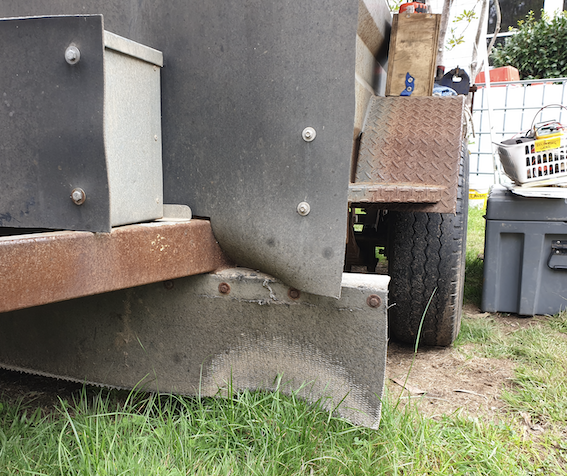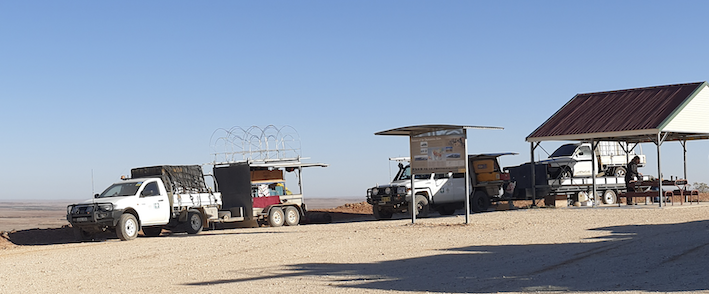Here’s what the ESS and Big Red Bash crew do when towing on outback roads
Photo: ESS vehicles towing trailers at Deon’s Lookout, Queensland on the way to set up for the Big Red Bash
ESS and Bash crew have been pulling trailers and vans behind 2WD cars, 4WDs and trucks for years and we’ve learned a few things on this journey.
What follows is our experience and it might help readers and others travelling on outback roads. We make no recommendations other than to say this is what works for us. Take from it what you find helpful.
The following information covers load balance and driving practices with a special focus on avoiding the extremely dangerous “death wobbles” as well as preparing trailers and vans for rough outback roads, tyre selection and more.
HITCH WEIGHT – THE KEY TO AVOIDING THE DEATH WOBBLES
This short video from the Caravan Association of Victoria shows how important weight distribution when loading a van or trailer can be to avoid the death wobbles.
When loading our trailers or vans we aim for roughly 10% of the total trailer weight to be pushing down on the tow hitch at the rear of the tow vehicle. For example if the trailer and load weighs say 2000kg, we’ll aim for between 180kg to 220kg down-force on the tow ball.
Different types of tow vehicles have different specs and requirements so the 10% number is only ever a “guideline”. You should also check your state government and manufacturer specifications.
We never tow trailers outside the manufacturer and govt maximums for total weight and braking requirements.
Our 5.5m tray flat top trailer weighs 1.4T empty and when pulled by our Land Cruiser 79 series the trailer has a gross vehicle mass (GVM) of 3.5T. It has full electric brakes and break away system. We never load it with more than 2.1 tons. We load it so that there is around 250kg on the tow hitch and only our ESS Land Cruiser is big enough and heavy enough (and has the electric brake controller) to tow this trailer.
Our smaller 8X5 box trailers are rated for loads of about 1 ton and have over-ride brakes only on the front wheels. Smaller 4WDs and cars can tow these trailers. We use the 10% guideline for tow hitch weight when loading these trailers. For example we load a trailer with a GVM of 1.8 tons to get 180kg down force on the tow hitch.
We now provide tow vehicles with a set of tow hitch weight scales so drivers can check the tow hitch weight before departure. We use a set of scales like this unit.
Case study 1
As an inexperienced 21 year old in the early 80s I was towing a medium sized, tandem axle , un-braked box trailer on the Melba Highway between Melbourne and Benalla. The trailer was loaded to less than the maximum rated weight with concrete breeze blocks but descending a long gentle hill I got the death wobbles. I knew enough to stay off the car’s brakes and rode the wobble until enough speed washed off and the car and trailer came to a halt in the roadside ditch in a cloud of gravel and dust. Both trailer passenger-side tyres had been torn off their rims, the rear wheel on the car was pushed off the rim and the welds that held the tow hitch to the trailer draw bar were ripped away (the chains held). But miraculously the rest of the trailer and car were okay. This caused me to look into what caused these death wobbles.
I now know that I had loaded the trailer with too much weight to the rear of the balance point. So when the trailer started to wobble it quickly developed a mind of its own and the wobble increased until the rear of the car was being dragged right across the bitumen kicking up gravel on both sides of the two-lane road. I was lucky there was no oncoming traffic.
Case study 2
At the Bash a few years ago we had a covered box trailer that had a few heavy items loaded late and unexpectedly that was loaded right at the rear door. The couple driving it from Sydney to Birdsville had a nightmare trip – every time they went over 85km it’d start to death wobble. They weren’t able to stop and redistribute the load so they had a slow, awful trip.
Since then all loading has been done with more care to load the contents to have enough load over the tow hitch and this never happened again.
PROTECTING THE TOWED TRAILER OR VAN FROM ROCK DAMAGE
Lots of the outback roads we traverse are covered in stones and rocks up to 90mm in diameter. We have generous schedules so our drivers are able to drive slowly enough to be able to spot and avoid the bigger rocks however it’s common that for most of the time on these roads the underside of vehicles and trailers will be peppered by smaller rocks. These rocks can do a lot of damage to exposed materials like plastics, thin cables, pipes and electrical wiring.
Rubber matting stone guards. We fit full-width rubber stone guards to the fronts of all trailers plus extra stone guards in front of all sensitive components such as brake units, electric wiring and similar. These stone guards are fitted as close to the front of the trailer as we can. Sometimes we weld or bolt a steel angle at the front under the draw bar to attach the rubber. We use old 6mm or 8mm conveyor belt rubber but you can find similar at Clarke Rubber or other suppliers. Look for a rubber with a tough internal fabric weave. The right rubber can be cut with a sharp Stanley knife and bolted to the frame and will survive for a few years of outback stone assaults.
Some crew attach 3mm polyethelene or similar to the front-facing surfaces of their vans with good results and it’s lighter than rubber matting.

Photo: Rubber conveyor belt matting 6mm used to protect the front of our 8X5, double axle workshop trailer. The lower flap protects the brake cable, drum brakes and u-bolts. The upper matting protects the front of the trailer and reduces rock rebound onto the tow vehicle.
Move or protect the wiring and plumbing. We routinely re-route all exposed electrical wiring or pipes to put them inside the steel or alloy frame or we cover them with steel or a couple of layers of corrugated split conduit or heavy-duty spiral wrap hose protection (available from hydraulic hose suppliers). Pool noodles held in place with cable ties can provide protection for one short trip but will need replacing regularly.
AVOIDING STONE REBOUNDS ONTO TOW VEHICLE REAR WINDOWS
With so many rocks getting airborne behind a tow vehicle it’s quite common for a flying rock to strike the front of a trailer or van and rebound towards the back of the tow vehicle. This has led to many broken rear windows and damage to vulnerable car parts. One year we even had a sponsored Amarok ute with a tub tray lose the cabin rear window to a rebounding rock from a little box trailer it was towing. Those rocks can go a long way.
Our solution is in two parts:
- Prevention – we have some crew who use a proprietary solution like Rock Tamers or Stone Stompers that fit to the rear of the tow vehicle or trailer that reduce the airborne rocks that rise to bounce off the trailer (we’ve seen some good DIY systems made too). Otherwise simply attaching rubber to the front surfaces of a trailer will also reduce rock rebounds, this is what we do to our trailers (see photo).
- Protection – fit a layer of something to the back of the tow vehicle so that rebounding rocks can’t do much damage. Real estate corflute signs are popular, as is cardboard or fancier solutions using more durable materials. For really good protection you can do both.
TRAILER MAINTENANCE
Our trailers do many thousands of outback kilometres every year so our maintenance regime includes:
Pre-trip:
- Inspect and re-pack the wheel bearings annually before we head to the bash.
- Inspect the brake cables on over-ride brake units. We routinely replace the supplied 3mm brake cables with 6mm cable for outback roads and we swage the terminations. The small u-bolt cable terminations that are often supplied on a city trailer last less than 100km on the Windorah-Birdsville road.
During the trip:
- On long trips check the brake cables, spring u-bolts and other vulnerable parts at intervals.
- Do a daily, manual check of trailer brakes. Complex electric brakes are especially prone to wiring damage.
TYRES FOR TRAILERS ON OUTBACK ROADS
In an ideal world the trailer tyres will match the tow vehicle – this gives more spare tyres for both vehicles. But with such a variety of trailer and tow vehicle combinations we don’t have that luxury so we simply make sure all tyres are not too old and we have a spare for each. When replacing tyres we usually spend a little extra and get light truck rated tyres for trailers. We rarely carry two spares any more (see the previous post about tyre pressures that explains our reasoning).
Avoid low profile tyres where possible. With less tyre wall in play there simply isn’t as much tyre between the metal rim and the rocky road surface so larger rocks are more likely to hit the rims and do damage or cause pinch-flats.
WHAT ABOUT SWAY BARS AND WEIGHT DISTRIBUTION HITCHES?
We have little experience with sway bars on trailers or vans so can’t add much helpful comment.
We haven’t installed sway bars on any ESS vehicles and none of our other crew trailers have them. Some of our crew tow vans with sway bars or weight distribution hitches and like them.
Our thinking at ESS is that if trailers are loaded with the correct amount of downward pressure on the tow hitch sway bars are not needed. So far this has proved to be adequate for our operations although I’d happily consider sway bars if someone proves a benefit. We tend to be very pragmatic with our fleet dollars and unless there’s an obvious, proven benefit we’ll stick to the most basic set up that gets the job done safely.
VENTS
We see people taping over vents on vans to reduce dust entry. Just remember that these vents must be uncovered and functional when using gas appliances inside the van for your safety.
Lucas Trihey 26/01/2020
With thanks to our machinery operator and Bash regular Don Coleman for contributing.
